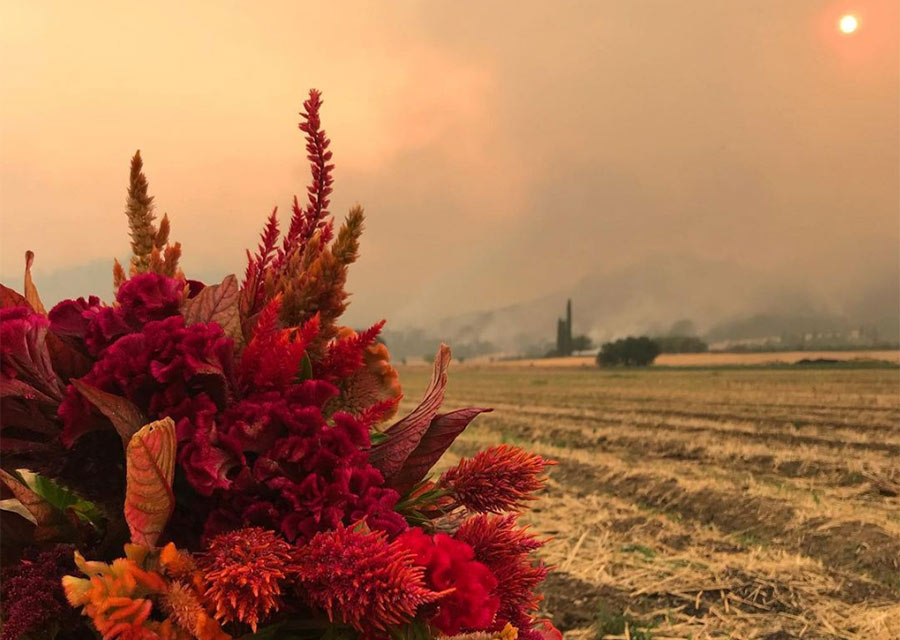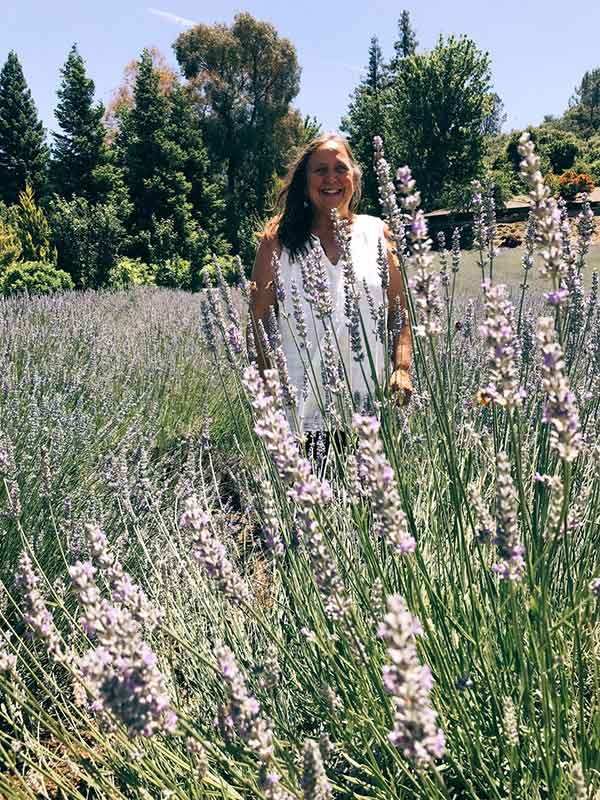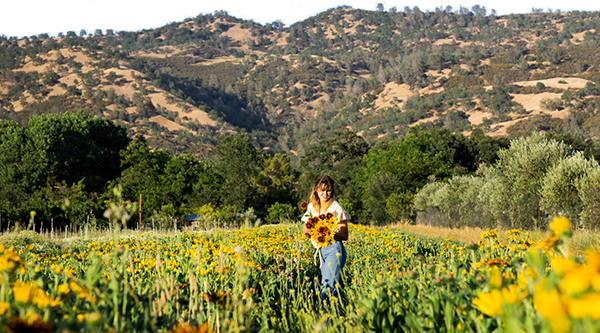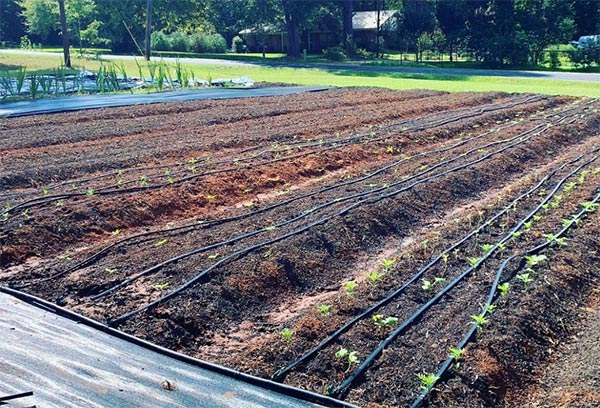- 3 Easy, Reliable, Productive Cut Flowers: Sunflowers, Zinnias & Rudbeckia
- 5 Factors That Determine Vase Life of Cut Flowers
- 2019 American Flowers Week: Combining the Art of Floral Design & Couture
- Celebrate the 7th American Flowers Week | Johnny's 2021 Botanical Couture
- Celebrating the 8th American Flowers Week | Johnny's 2022 Botanical Couture
- Collective Selling Models for Flower Farmers: Flower Hubs That Work
- 5 Cool Flowers to Plant Now | Lisa Mason Ziegler's Secrets for Growing Hardy, Cool-Season Annuals
- Cut-Flower Harvesting & Post-Harvest Care | Best Practices from Pros in the Slow Flower Community
- Cut-Flower Kit | Guide for Market Growers (PDF)
- Easy Cut-Flower Garden Map | For Growers New to Flowers (PDF)
- Easy Cut-Flower Garden Planner | For Growers New to Flowers (PDF)
- From Color to Climate: 5 Floricultural Trends Subtle & Seismic
- Flower Culture by Crop | Comparison Chart | Days to Germination, Weeks to Transplant, Days to Harvest (PDF)
- Flower Farmers' Favorite Fillers & Foliage | Recommendations from 3 Farmer-Florists
- Getting Started in Cut-Flowers | Top 15 Cuts
- Heat & Drought: How Flower Farmers Are Adapting to Changing & Challenging Climatic Conditions
- Introduction to Overwintering Flowers | Guide to Overwintering Flowers
- An Introduction to Producer Marketing Cooperatives | M Lund & Associates
- How Day Length Affects Cut-Flower Production
- Growing Flowers in Hoophouses & High Tunnels: Cool-Weather & Hot-Weather Options
- Starting a U-Pick Flower Farm, From A-to-Z
- Growing Flower Seedlings for Profit
- Roadside Flower Stand Basics: Success Tips for On-Farm Retail
- Year-Round Flower Production Strategy
- Overwinter Flower Trials | Multiyear Results for 30+ Crops | Johnny's Selected Seeds | XLSX
- Seeding Date Calculator | Johnny's Recommended Flowers for Overwintering | XLSX
- Pricing & Profitability for Flower-Farmers | Pointers from a Diversity of Pros
- Sustainable Farming Methods | A Survey of Flower Farmers' Best Practices
- Just Add Flowers | An Introduction to Companion Planting for Vegetable & Herb Gardeners
- Slow Flowers Palette & Petal Crushes | Evolving Colors & Shape-Shifts in Floral Industry Trends
- Johnny's and Slow Flowers | Johnny's Selected Seeds
- Slow Flowers | Celebrating Fifth-Season Regional Design Elements
- Slow Flowers Floral Forecast | A Summary of Industry Insights & Trends
- Building a Better Market Bouquet: Tips, Techniques & Recipes for Flower Farmers
- Slow Flowers | Tips for Staging On-Farm Floral Workshops | Johnny's Selected Seeds
- Wedding Wisdom 101 | 10 Beginner Tips for Entering the Wedding Floral Landscape
- Succession-Planting Flowers | Scheduling & Planning, Sowing Frequency, Recordkeeping & Recommendations
- Succession-Planting Interval Chart for Flowers
- Sustainable Floral Design | Techniques & Mechanics for Foam-Free Floristry | Tobey Nelson & Debra Prinzing
- Video: Mason Jar Bouquet Tutorial
- Video: How to Build a Bouquet
- Video: Tobey Nelson | Sustainable Floral Design | Slow Flowers Summit
- Video: Economic Considerations in Overwintering Cut Flowers | Johnny's Selected Seeds
- Top 10 Cut-Flower Varieties for Direct Seeding
- Video: Floating Row Cover | Baby "Cool Flower" Protection from Whipping Winter Winds
- Video: The Procona System for All-in-one Flower Harvest, Transport & Display
- Johnny's Overwinter Flowers Tunnel: Trellising, Supports, Ground Cover & Spacing
- Video: Irrigation Considerations for the Overwinter Flowers Tunnel | Johnny's Selected Seeds
- Video: Johnny's Overwinter Flowers Trial Recap
- Video: Producer Cooperatives for Small-Scale Farmers | Johnny's Webinar Series
- Climate Adaptation for Vegetable & Flower Farmers | Johnny's Educational Webinar Resources
- Chrysal CVBN Flower Conditioner | SDS
- Webinar Slide Deck | New-for-2023 Flowers & Floral Supplies | PDF
- Chrysal Clear Bulb Flower Conditioner | SDS
- Chrysal Professional 2 Transport & Display T-Bag | SDS
- Chrysal Classic Professional 2 Transport & Display (Holding) Solution | SDS
- Chrysal Clear Universal Flower Conditioner | SDS
- Webinar Slide Deck | Flower Growing in Southern States | PDF
- Choosing Flower Crops to Overwinter | Guide to Overwintering Flowers
- Edible Flowers List: Top 20 Favorites from the Slow Flowers Community
- Floral Standards for Flower Farm Collectives and Cooperatives
- Bloom to Boom: Flower Farm Profitability
- Choosing Tulip Varieties for Forcing | Guide to Forcing Flower Bulbs
- Forcing Tulip Bulbs | Guide to Forcing Flower Bulbs
- Snapdragon Groups Explained
- Flowering in the South: Profiles of 5 flower farmers who cope with temperature, humidity, pest & weed pressure
- Video: Flower Growing in Southern States | Johnny's Webinar Series
- 10 Tips for Building a Profitable Cut-Flower Business
- Introduction to Forcing Flower Bulbs in Soil | Guide to Forcing Flower Bulbs
- U-Pick Power for Your Flower Farm | Johnny's Webinar Series
- Eat Your Flowers: Serve Up That Wow Factor With Edible Flowers
- U-Pick Power for Your Flower Farm | Johnny's Webinar Series
- Flower Growing in Southern States | Johnny's Educational Webinar Series
- Chrysal Clear Bulb T-Bag | Cut-Flower Conditioner | SDS
- Chrysal Professional 1 Hydration Solution | SDS
- Chrysal Professional 3 Vase Solution Powder | SDS
- When to Start Seeds for Overwintered Flowers | Guide to Overwintering Flowers
- Webinar Slide Deck | U-Pick Power for Your Flower Farm | PDF
5 Flower Farmers from Varying Geozones & Operations Share Strategies & Tactics
As Hudson Valley flower farmer Marybeth Wehrung reflects on 2020, she doesn't just consider it the year the pandemic arrived. It began with a warm winter, followed by unseasonably late spring frost, a sustained lack of precipitation all summer, and the concluding heartbreak of an early fall frost. It might have been easy to blame herself for crop failures, but on closer review of all that went on at Stars of the Meadow in Accord, New York, her 1-acre flower farm, Marybeth realizes she's dealing with forces far greater than farming methods and decision-making alone.
"While my first question was, 'What could I have done differently?,' " she recognizes that "there are many factors, climate- and weather-related, that contribute to success and failure. If we farmers don't take the great variability in shifting climate patterns into consideration, then we will be too hard on ourselves."
Water retention practices in sustainable farming
- Low-till/no-till. Aerate with human-powered broadforking. Tarp and solarize to reduce the weed seed bank. Hold on to moisture with hügelkultur raised beds.
- Add compost to increase the percentage of organic matter in your soil. Per the NRDC, 1% increase in organic matter increases water-holding capacity (WHC) by 20K gal/acre. Bonus: compost increases fertility.
- Develop an irrigation strategy. Set up a rainwater collection system. Invest in a vineyard/orchard/drip irrigation to save precious water resources and maximize moisture delivery to root systems. Irrigate in the coolest, early part of the day to reduce evaporation.
- Don't let your soil go bare naked. Use cover-cropping between rows, on fallow plots, or other areas of exposed soil. Lay landscape fabric and weed barrier mulches to prevent evaporation via soil exposure.
She finds herself walking two parallel paths. On a macro level, Marybeth knows that she and every other farmer face reality on a daily basis, with small and large actions. On a micro level, she's implementing new tactics to care for her crops. "Climate change is not a concept; it is real and it is here. It is altering our ability to continue to farm in the same old way and still make a living, as well as the way we care for our health and our work. We have to normalize the conversation toward the reality rather than push it away."
Based in Norfolk, Virginia, Dee Hall has noticed changing conditions as well. A lifelong gardener who has turned her passion into Mermaid City Flowers, a "very small, micro, micro-farm," Dee says it's impossible to miss the effects of climate change when she walks through her neighborhood at high tide. "Norfolk is one of those cities that tends to be heavily affected by flooding, yet can also be relentlessly dry and hot. We've had so many unusual weather events that the new 'normal' is to have all types of unprecedented weather events."
Marybeth and Dee are not alone as they seek practical ways to address climate challenges as flower farmers. In the 2021 Slow Flowers Member Survey nearly 60% of respondents cited weather irregularities (too much or too little rain) as impacting their floral enterprise. Thirty percent noted having abnormally warm or abnormally cool spring seasons; 25% experienced early fall frost; and nearly 20% blamed natural disaster-related damage (wildfire, flooding, hurricane, hail, tornadoes, and other weather tragedies), as well as extended hot periods with no precipitation.
With similar prospects facing floral agriculture for the 2021 growing season, we asked several Slow Flowers members how they are preparing. Here, 5 flower farmers from varying geographical zones and differently-sized operations share their climate coping strategies and tactics.CENTRAL CALIFORNIA • Zone 9b
Deep Mulch + Drip Irrigation + Resilient Crop Mix + Native Perennials
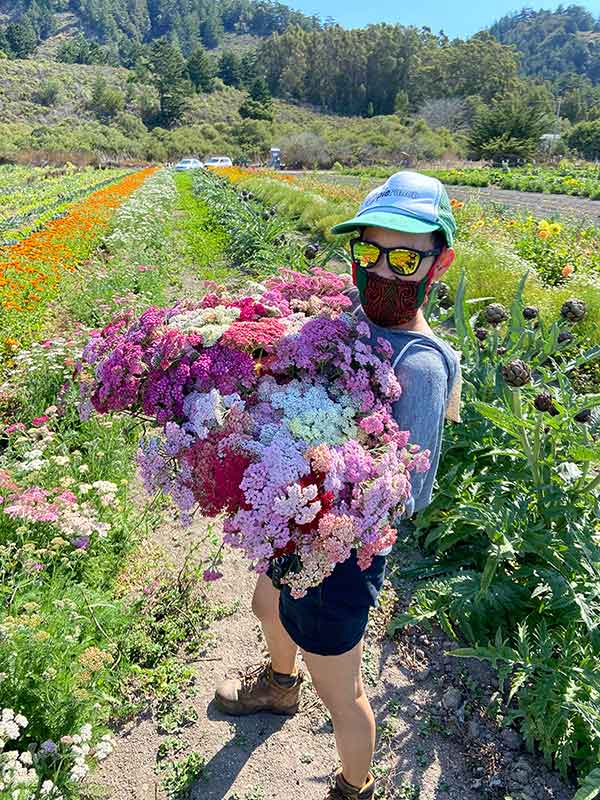
Photo courtesy of Kellee Matsushita–Tseng
Kellee Matsushita–Tseng is an instructor at University of California, Santa Cruz's famed Center for Agroecology and Sustainable Food Systems (CASFS), specializing in cut-flower growing and working directly with student apprentices. Approximately 10 acres of the program's farm are devoted to the teaching garden, field crops, greenhouses, and classrooms housed on the UC Santa Cruz campus on California's Central Coast. There, faculty and apprentices grow food and flowers for sale to the community and to serve campus programs.
Historically, the area receives 30" of annual rainfall. "We're at around 15" so far this year and there's no rain expected anywhere in the near forecast, which is really worrying," Kellee says. Farms in the Bay Area consistently cope with drought, although that hasn't been an issue for the UC Santa Cruz campus, which relies on a city water system and primarily uses drip irrigation. Kellee says she's aware of many farms struggling with access to water or threat of seasonal wildfires.
"We teach diversity in the entire farming system, from diversity of species to designing for resilience. But now, there's the huge extra component, and psychological stress, of fire and drought having become so real in the past few years." One small but significant example: Kellee knows of many local farms that are "rush-purchasing" masks for workers so they can be prepared for the fire season.
Fire threat will continue to plague much of agriculture in the West, and Kellee is also aware of growers taking extreme measures to fireproof their farm operations. "They're even thinking of buying fireproof containers for the property," she notes.
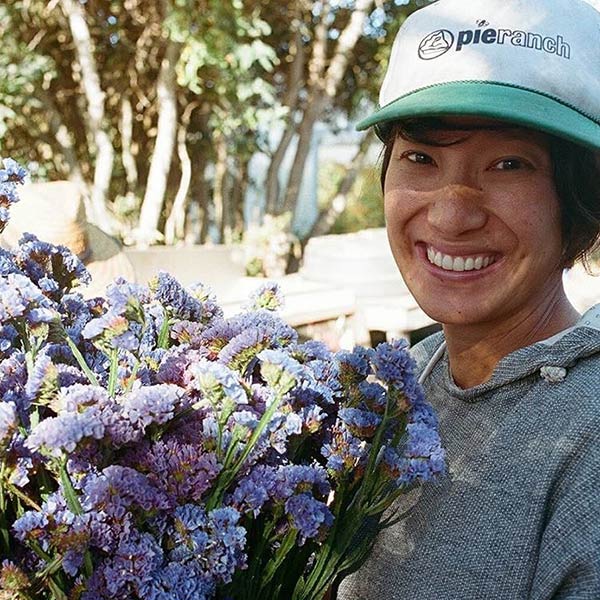
Photo courtesy of Kellee Matsushita–Tseng
Clearly, heat from fires can melt drip irrigation lines, which is just one more good reason to use heavy organic mulching. "It's probably fairly obvious, but creating soil with higher levels of organic matter supports the resiliency of plants throughout the season," Kellee explains. This approach was particularly important during last summer's wildfire evacuations. "Just knowing that our soil had high organic matter was helpful. We were not able to irrigate for weeks during the middle of last season. Things held up fairly well and some of our plantings survived, even when we couldn't gain access to the campus farm for more than 2 weeks."
This year Kellee has reevaluated the mix of cut-flower varieties being grown, to reduce "species that are less resilient or that require higher levels of water or fertility."
In addition to assessing resource consumption of all crops, she is building up perennial planting areas. "We've planted some native perennials to incorporate into floral designs, and we're redesigning our native and beneficial plantings, including installing five 100-foot plantings of native perennials in each of the main field blocks that will provide cut-flower material, habitat, nectar, and food resources for beneficial organisms."
Kellee notes that extreme heat is not so much an issue in her area, but moreso in other areas of California, where flower farmers are going to extremes to farm in the coolest times of the day. "I know people who are now farming by headlamp or tractoring in the nighttime!" From her standpoint, however, "It is more that erratic temperatures and unseasonably hot or cold periods make flower growing challenging and impact harvest predictions and reliability."NORTHERN CALIFORNIA • Zone 9a
Deep Mulch + Heat-Loving Crops + Time, Labor & Irrigation Efficiencies
Dru Rivers and her family have been farming food and flowers for the past 37 years at Full Belly Farm in Guinda, California, a 400-acre certified organic, diversified farm. Hannah Rose Muller, Dru's daughter, operates Full Belly Floral, growing cut-flowers on 15 of those acres to supply Full Belly's CSA subscribers, farmers' markets, and area grocery stores, as well as design services for weddings and events.
According to Dru, heat is ever-present in their region, just outside of the Sacramento Valley. "We have had some extreme years, which in the 1980s we called 'geological change' but which we now acknowledge to be part of a bigger pattern of climate change."
Wildfires across the West threaten farmland, and 2020 was a tough one for California, Dru notes. "We had wildfire come right up to the border of the farm. We were working in smoke for approximately 4 weeks. Never mind COVID masks; we had masks for smoke. I think we'll get over having insufficient rainfall, but it would be a blessing if we could reduce the threat of fire," she says.
Full Belly has long implemented policies to mitigate heat stress on those working in the fields. "Time management of our labor is really important, as we want it to be physically safe to work here. With a crew of nearly 100 at the height of the season, every field has shade and water. There are strict guidelines about how to manage labor in the heat, and we do a lot of training. Every truck has an ice cooler, and we start the crew much earlier in the day and end earlier in the afternoon when it's really hot," Dru says.
Like the USCS campus on the Central Coast, Northern California's winter rainfall (October 2020–March 2021) produced just a fraction (5") of the region's average winter rainfall of 24". The farm received just 9" of rainfall during winter 2019–2020, but endured 40" of rain, or nearly twice the average precipitation, during the prior season (2018–2019).
"I have 'farmer optimism,' and every year I think, 'Maybe last year was an anomaly, that it was so hot or dry,' " Dru says. "But now we have to wonder, 'Is this going to continue?' If it does, we're going to have to make some more serious adjustments."
Full Belly's irrigation comes from a combination of well water and a flood-controlled river, to which the farm has riparian rights and which this year is expected to provide 8 weeks of irrigation, instead of the normal 16 weeks, Dru says. "Our main strategies involve trying to be as efficient as possible with any water that we use," she continues. "So all of our flowers receive drip irrigation, but we've been really focused on heavy mulching instead of leaving bare soil," including straw mulch and composted mulch.
At the same time, the number of 100-plus degree days seems to be increasing in recent years, and the flower farmers at Full Belly lean into that reality. "We focus on crops and varieties that love the heat. Our big-four summer flowers include sunflowers, marigolds, celosia and zinnias, plus we grow amaranth," Dru says. Apart from the permanent perennial plantings, the field annuals are rotated each year.
She's hopeful that water-saving devices and heavy mulching will continue to be enough. "Our flowers have high value. If we're going to come to some decision-making about what we grow here because of lack of water, I think we'd keep flowers but perhaps eliminate sweet corn or something else that's a high water user. When our resources are limited and we need the income, I'd say go for the flowers instead of planting lettuce."EASTERN TEXAS • Zone 8b
Deep Mulch + Protective Shade + Texas Big 5 Heat-Loving Annuals
Photo courtesy of Alice Creek Flowers
In her fourth season, Lacey Russell is a specialty cut-flower grower who farms on one-quarter acre in the Piney Woods ecoregion of East Texas. She operates Alice Creek Flowers on family land in Whitehouse, Texas. In addition to supplying two area florists and running a CSA bouquet subscription program, Lacey helped to start the new Whitehouse Farmer's Market, which debuted this spring.
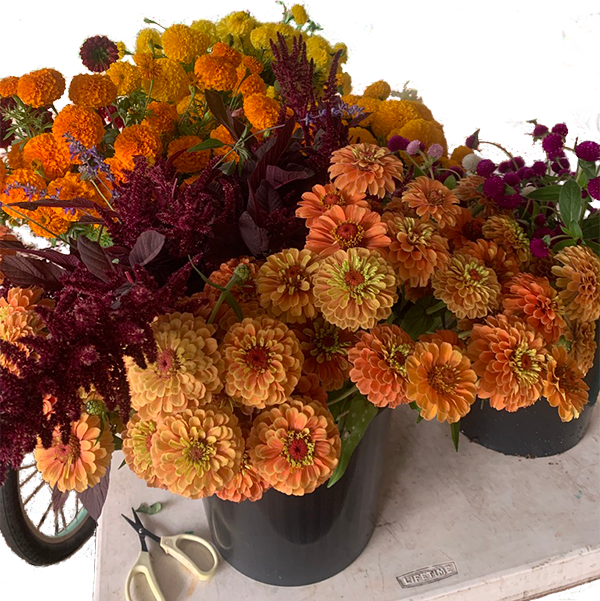
Lacey creates mulch with pine needles mixed with leaves and another abundant natural material — cotton burr compost, a byproduct of cotton production.
Heat is more of an issue for her operation than precipitation, and through trial and experimentation, Lacey has tailored how she treats certain crops to help them thrive through mid- to late-summer heat blasts.
For example, she realized that her dahlias needed more protection after enduring full-sun conditions in July and August. "I had two options: either build a shade structure or, as I did, move them to where we have tree protection from the searing afternoon heat that toasts them," she says.
Lacey relies on a crop of heat-loving summer annuals that one of her mentors, Pamela Arnosky of Texas Specialty Cut Flowers, calls the "big five. "They're really all the annuals we can grow in the Texas heat — sunflowers, zinnias, celosia, gomphrena, and marigolds — plus I add basil as a foliage or filler," Lacey says.
In order to enjoy what is essentially a "second spring" during a sustained and temperate fall season, Lacey uses a shade structure to start and establish plants like snapdragons during the heat of summer. "Picture a high tunnel structure, but instead of covering it in frost cloth, it's covered in shade cloth," she explains. "The shade cloth protects the young plants from the heat." If all goes well, she'll be able to harvest snaps and other annuals until November 15, the expected frost date.
MID HUDSON VALLEY NEW YORK • Zone 5b/6a
Diversified Crops + Low-Till + Deep Mulch
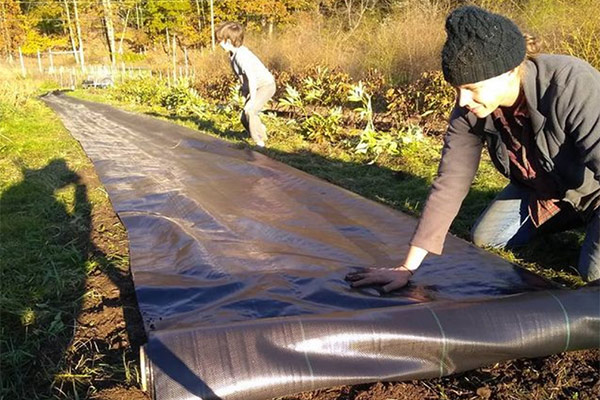
Photo courtesy of Stars of the Meadow
Learn more about Mulches & Landscape Fabrics…
Learn more about Silage Tarps…
Before she started Stars of the Meadow as a sustainable cut-flower farm in 2013, Marybeth Wehrung grew and made herbal medicines for several years. She now farms a diversity of field flowers and sells through a number of channels, including a bouquet add-on for another farm's vegetable CSA, as well as to local florists and to farmers' market shoppers in the New York City suburbs.
Marybeth identifies several crops that took a hit during the 2020 season due to weather irregularities. "In the past 4 or 5 years, I've begun to have a building dread about the climate," she admits. "Last year, I started to absorb the reality."
Stock, an early-season annual she relies on for bouquet designs, presented the first challenge of the year. Despite using the same high tunnel methods from past seasons, "we had so many pounding cold nights in May that I lost a portion of my crop," Marybeth explains. She almost eliminated stock altogether when planning for 2021, but decided instead to cut inventory by half. "I'll give it another chance," she laughs. "I'm also going to seed two-per-cell and leave two seedlings so there's increased odds of getting a double flower. And rather than have a whole tunnel of stock, I'm going to diversify what I'm planting with annuals that are a little hardier, such as the Chantilly Series snapdragons and dianthus."
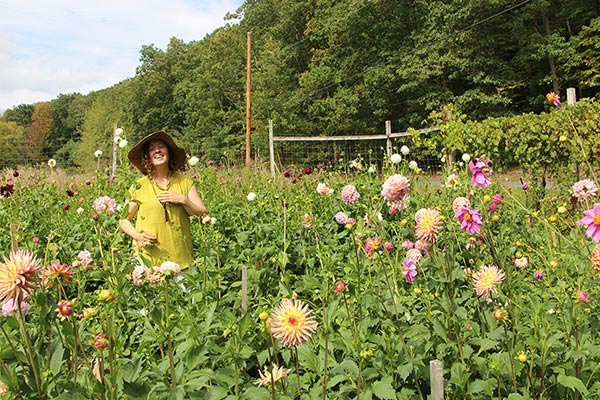
Photo courtesy of Stars of the Meadow
Stars of the Meadow's peony and Dutch iris crops also took a hit from colder-than-average temperatures last year. "These are perennials that are very cold-tolerant, and in the past, I've seen them take a frost and do alright. Last year, the earlier-blooming peonies, for example, formed buds when we had slightly more moderate weather — so they were tough enough to take the cold and then bloom. But the later-blooming varieties got too much cold during the bud-formation stage, and those tiny buds didn't survive," she says.
Marybeth seeded bupleurum over the failed iris bed, hoping to "get another crop from that real estate." For 2021, she plans to add more cold protection for her two 100-foot beds of peonies and Dutch iris.
Dahlia planting was delayed due to the cold spring, then suffered anew from last summer's extended drought. "In addition to the lack of rainfall, I cannot irrigate as much or as quickly as I want to because I share a well, and the low pressure slows the push of water throughout the drip system."
Low-till methods and full mulch cover are part of her water retention strategy, but ultimately, "because of so little rainfall, my dahlias stalled," she explains. "They didn't grow as fast and they didn't bloom until early September." All would have been safe but for the early frost that hit Hudson Valley on September 19th and lasted for four nights. "I only really had three weeks to sell my dahlias. It was a mass casualty."
Marybeth plans to relocate the tubers to a different spot on her farm where frost may not settle so quickly. She also has tried to mitigate the negatives by opening up a tuber sale on her website. "I decided not to dedicate more space to dahlias, knowing they are a frost liability. The deal I've made with myself is to treat the dahlias as a double-yield drop. By selling the tubers, I'm hoping to offset all of the planting, digging, and dividing labor and recoup part of that investment rather than simply composting the tubers."
SOUTHEASTERN COASTAL VIRGINIA • Zone 8a
Native Perennials + Rain Harvesting + Recordkeeping + Growing Community

Photo courtesy of Mermaid City Flowers
At Mermaid City Flowers, Dee Hall grows cut flowers in her one-quarter acre residential garden, selling through two farmers' markets and offering bouquets and subscription CSAs to customers within a 10–15-mile radius.
Swings in temperature this past March — from 90°F one week to late frost the next — required constant observation and adjustment, she explains. That meant using protective Agribon to cover low-hoop tunnels where anemone, ranunculus, bachelor's button, and snapdragons are growing, then later pulling off the row covers and mulching with hay to cool the soil.
In addition to cultivated crops, Dee grows native perennials — eryngium, penstemon, yarrow, St. John's Wort, phlox, and creeping phlox. "I want to grow plants that already have the adaptability to thrive in this environment, and work with the climate rather than having to go to extremes all the time," she says.
Rainwater harvesting is an ongoing project, with 50- and 80-gallon rain barrels in place. "I'm investigating the possibility of getting an IBC tank, which will give me greater capacity to conserve and use rainwater," Dee explains. "I am also hoping to institute a passive solar irrigation system. Part of my garden lies across a slope, so I'm trying to figure out how I can use rainwater catchment to deliver irrigation to those plants."
Two other strategies, which might seem intuitive to some growers, are helping Dee feel better prepared for the 2021 season. One is her relentless recordkeeping and use of photos to document and measure how her crops perform, year-to-year. And the other is a human factor. Dee formed the Tidewater Flower Collective and invited other small cut-flower farm owners in her area to join, hoping to build a community for networking and mutual encouragement. "I gathered up everybody I could find and asked them to be part of the group," she says. "There are 8 of us now, which is not huge, except that 2 years ago, I couldn't find anyone. We've gained momentum now, and it's good to have people near me who have history as gardeners, if not farmers."
Climate Resiliency
Look Both Ways + Stay Fleet-Footed
Now in her seventh season, Marybeth Wehrung recognizes that farmers have been weather-watching for generations. "Long-term farmers have experienced weather cycles over decades, and people in farm families share and pass this knowledge down for generations. As a newer farmer, however, I didn't have that background and blamed myself for lots of weather-related challenges that were not my fault."
Moving into the 2021 season, Marybeth's strategy is one that all flower farmers can adopt. "Staying flexible, not getting too married to our techniques, can help farmers adjust to rapidly changing situations. It increases our resiliency, because sticking to the same practices might hold us back at times.
"The weird thing about the erratic climate is that we may have to install drainage systems for wet seasons as well as water-holding strategies for periods of drought. Climate-resilient farming means having to look at both hot/dry and wet/cold in new ways and prepare for bigger highs, bigger lows, and longer periods in between."
Learn More
- Natural Water Retention Measures (NWRM). No-till agriculture.
- Compost increases the water holding capacity of droughty soils: How to choose compost that increases the soil's water holding capacity. Michigan State University Extension.
- Organic matter can improve your soil's water holding capacity. Natural Resource Defense Council. Expert blog.
"The weather pattern in the Midwest has shifted. Hard, fast rains will be followed by long periods of drought, and soil under conventional production agriculture can't keep up with the changing climate." - Fourth National Climate Assessment (2018). Volume II: Impacts, Risks, and Adaptation in the United States. GlobalChange.gov. (The Fifth NCA is in development at the time of this writing.)
"Rising temperatures, extreme heat, drought, wildfire on rangelands, and heavy downpours are expected to increasingly disrupt agricultural productivity in the United States. Expected increases in challenges to livestock health, declines in crop yields and quality, and changes in extreme events in the United States and abroad threaten rural livelihoods, sustainable food security, and price stability." - Powering Agriculture: An Energy Grand Challenge for Development. Toolbox on Solar-Powered Irrigation Systems (SPIS). Energypedia.info.
- Extreme Weather and Climate Change. See: U.S. Drought Events Since 2000. Center for Climate and Energy Solutions.
- U.S. Drought Monitor (USDM): Maps • Data on Drought, Severity & Coverage Index [DSCI]) • Conditions • Outlook. University of Nebraska-Lincoln, United States Department of Agriculture, and the National Oceanic and Atmospheric Administration.


